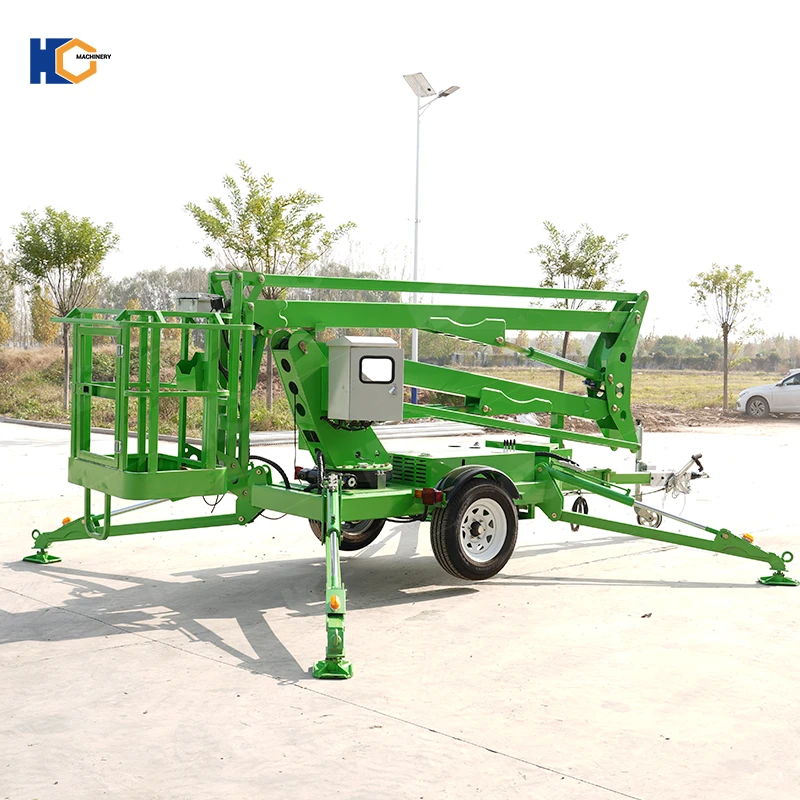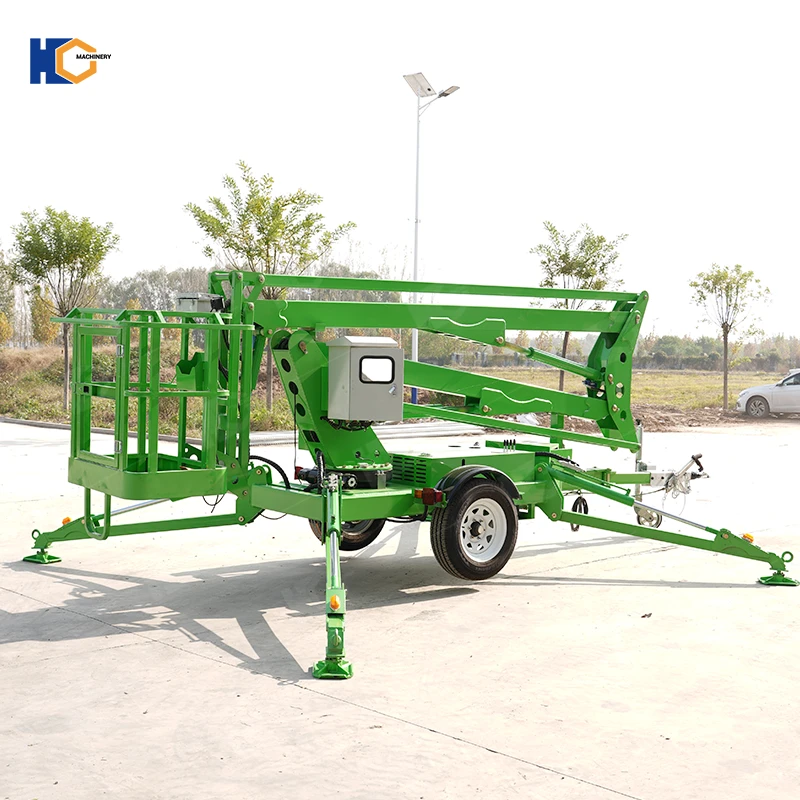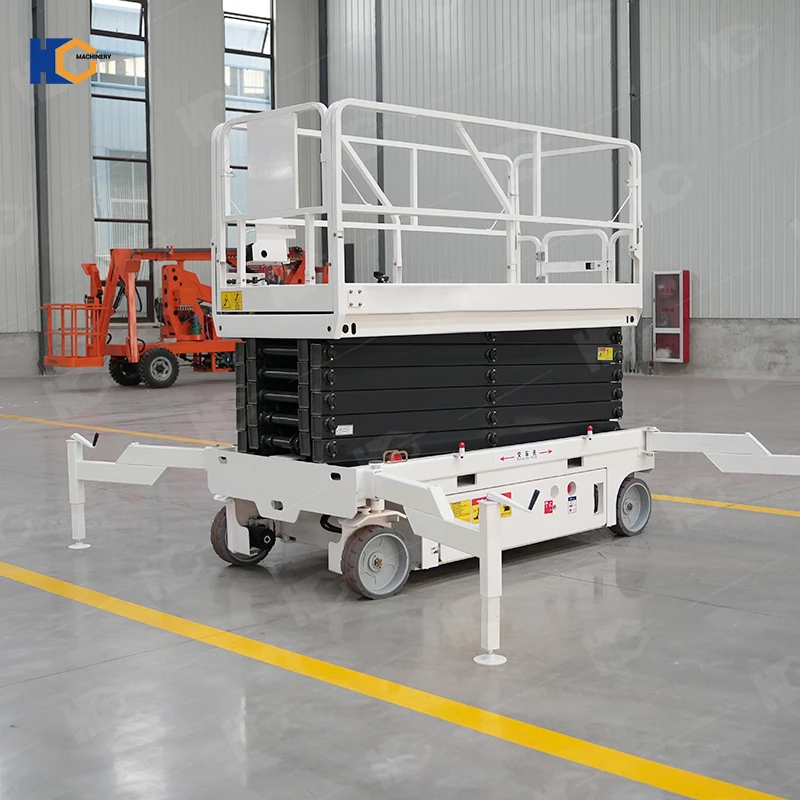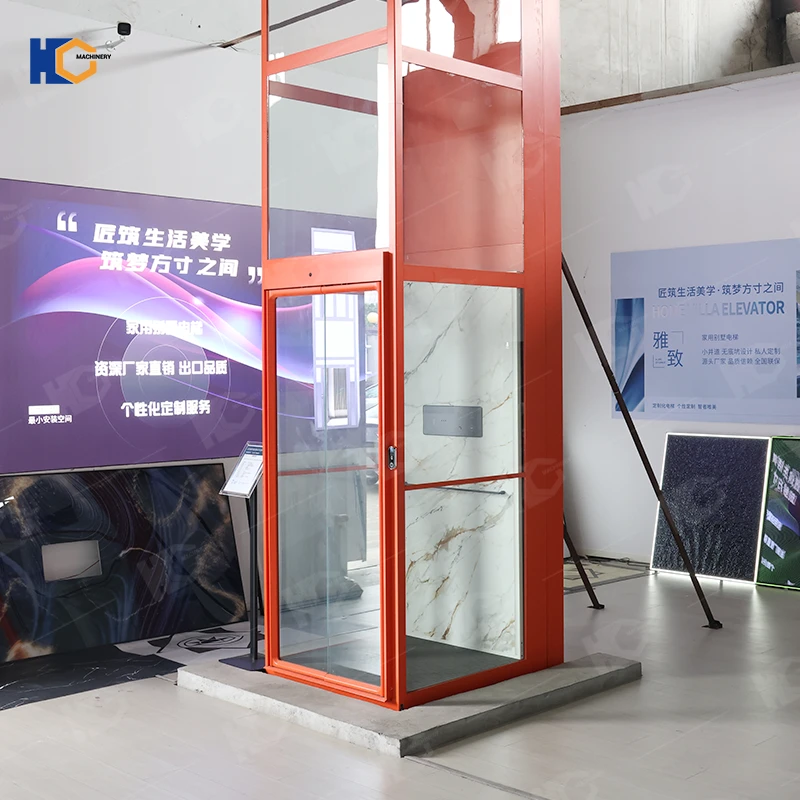A boom lift is a type of aerial work platform designed to lift workers, tools, and materials to elevated areas that are hard to reach. Compared with scaffolding or ladders, boom lifts offer more height, more flexibility, and far better safety. That’s why they’ve become essential across construction, maintenance, manufacturing, and emergency operations.
Types of boom lifts
1. Telescopic Boom Lift (Straight Boom)
This is the long, straight-reaching type.
Its boom extends linearly, like a giant mechanical arm.
Use it when you need maximum horizontal or vertical reach.
Typical specs:
• Max height: 120–185 ft (36–56 m)
• Horizontal outreach: up to 80 ft (24 m)
• Load capacity: 230–450 kg
Best for high-rise construction, industrial maintenance, and outdoor work where obstacles are minimal.
2. Articulating Boom Lift (Knuckle Boom)
This one bends at multiple joints, like an elbow.
It can go up, over, and around obstacles—making it extremely useful.
Typical specs:
• Height: 40–150 ft (12–45 m)
• Outreach: 20–70 ft (6–21 m)
Best for work around pipes, beams, machinery, trees, signs, and building corners. This is our previously released Articulating Boom Lift product. Images and specifications are available here, you can click to view them: 30 ft 40 ft 45 ft 50 ft 55 ft 60 ft Articulating Boom Lift manufacturer
,
3. Towable Boom Lift (Trailer-Mounted Boom Lift)
This type is attached to a vehicle and towed like a trailer.
It’s lightweight and easy to move between job sites.
Specs:
• Height: 34–60 ft (10–18 m)
• Platform capacity: 120–200 kg
Popular with small contractors, electricians, painters, and facility managers. These are some of the products we've previously released. Here are pictures and specifications; you can click to view them: 30 ft 35 ft 40 ft 45 ft 50 ft 60 ft 65 ft Electric articulated boom lift factory
4. Spider Boom Lift (Tracked Boom Lift)
This one sits on spider-like crawler tracks.
Its legs or outriggers stabilize it on slopes, soft soil, or tight indoor positions.
Specs:
• Height: 50–150 ft (15–45 m)
• Weight: much lighter than standard booms—friendly for delicate floors
Used in churches, atriums, malls, parks, and uneven outdoor terrain.
5. Self-Propelled Boom Lift (Electric or Diesel)
“Self-propelled” simply means it moves under its own power while elevated.
Two subtypes:
• Electric boom lift – quiet, zero emissions, for indoor use
• Diesel boom lift – powerful, for rough outdoor terrain
These are the most common rental models worldwide. This is our previously released Self-Propelled Boom Lift product. Images and specifications are available here; please click to view: 14m Diesel Self-Propelled Boom Lift
6. Atrium Boom Lift (Compact Crawler Lift)
A special type of spider lift designed to fit through narrow doorways—some models are as narrow as 32 inches (81 cm).
Often used for:
• Hotel lobbies
• Airports
• Museums
• Shopping malls
7. Truck-Mounted Boom Lift
The boom is mounted on a truck chassis.
It’s fast to deploy and ideal for jobs that involve moving to multiple locations in a single day.
Used by:
• Utility companies
• Telecom service teams
• Street light maintenance crews
Heights can reach 150–300 ft (45–90 m).
In the last five years, global demand for boom lifts has increased steadily. According to the International Powered Access Federation (IPAF), boom lift rental demand grew by 7% annually from 2020–2024, driven mainly by warehouse automation, infrastructure expansion, and stricter building safety compliance. Boom lifts are no longer niche—they’re everywhere.
Let’s walk through the most common, practical, and data-supported uses of boom lifts today.

1. Construction and Building Access
Construction sites have always been the natural habitat of boom lifts.
Workers use them to handle tasks like:
• Exterior wall installation
• Roof edge waterproofing
• Window mounting
• Steel structure welding
• Rebar and formwork adjustments
A telescopic boom lift (straight boom) can reach up to 180 ft (55 m), which is why high-rise projects depend heavily on them.
Articulating boom lifts—those elbow-bending, flexible types—can maneuver around beams, pipes, and corners to reach areas that would normally require complex scaffolding.
Efficiency data:
A 2023 study from MEWP operators found that boom lifts reduce exterior construction time by 22–30%, mainly because they eliminate repeated scaffolding assembly & disassembly.
2. Maintenance of Buildings, Malls & Airports
Modern commercial buildings are taller and more irregularly shaped than ever. Boom lifts help technicians reach:
• Glass curtain walls
• High-bay lighting fixtures
• Big-screen signage
• Fire sprinkler systems
• HVAC ducting
Airports especially rely on them. An average international terminal changes light fixtures every 2,000–4,000 hours, and boom lifts are used in nearly all these operations.
3. Tree Trimming & Landscaping
Boom lifts are much safer than climbing ladders with a chainsaw in hand—the tree-trimming equivalent of juggling knives on a tightrope.
Arborists use articulated boom lifts to reach branches up to 80 ft high and to work around wide tree trunks or uneven ground. Cities use them for:
• Storm cleanup
• Seasonal trimming
• Park tree maintenance
Towable Boom Lifts for Tree Work in the USA
,This boom lift can be used in any country.4. Electrical Line & Utility Work
Utility companies rely on boom lifts to reach:
• Overhead power lines
• Traffic light systems
• Street lighting
• Communication cables
Rural areas often use telescopic booms because they provide long horizontal outreach—critical when the ground below is muddy, sloped, or obstructed.
Electric utilities report that boom lifts improve repair crew safety by up to 40%, reducing the number of ladder-related accidents.
5. Warehouse & Industrial Facility Work
Inside massive warehouses (especially Amazon-style hubs with 40–60 ft ceiling heights), boom lifts help with:
• High-level racking installation
• Conveyor system maintenance
• Overhead piping and ventilation repair
• Inventory camera installation
Industrial factories also rely on them for replacing large LED fixtures or maintaining robotic systems mounted high above work floors.
Boom lifts are particularly useful for renewable energy facilities—solar farms, wind turbine yards, hydroelectric stations—where precise elevated access is crucial.
6. Film, TV Production & Event Setup
The entertainment industry quietly uses boom lifts for almost every major event setup:
• Mounting overhead stage lights
• Installing audio arrays
• Aerial camera shots
• Hanging LED walls
• Rigging trusses
A large concert or stadium event may use 5–15 boom lifts at once, depending on the scale.
Film crews prefer boom lifts instead of drones in conditions with heavy wind, strict safety rules, or indoor filming.
7. Cleaning and Pressure Washing
This includes:
• Glass curtain wall cleaning
• High-rise signboard washing
• Stadium seating cleanup
• Bridge underside washing
Boom lifts offer the height and mobility that cleaning workers need when surfaces are 100–150 ft above ground.
8. Emergency Rescue & Disaster Response
Fire departments often use boom lifts (or specialized fire booms) to:
• Rescue people from tall buildings
• Access collapsed structures
• Deliver water or foam to high floors
• Assess damage after earthquakes
Boom lifts played a role in several major global disaster responses from 2018–2024, especially when traditional ladders couldn’t reach.
Why Boom Lifts Are Preferred: Practical Advantages
A few reasons they dominate modern high-reach work:
Height: up to 55 m
Horizontal outreach: up to 24 m
Load capacity: 200–450 kg
Setup time: usually under 5 minutes
Safety: harness points + stable platforms
Maneuverability: can rotate 360°, drive elevated, and bypass obstacles
Compared with scaffolding, boom lifts often reduce project time by 25–40%, depending on task complexity.
Conclusion
From construction sites and factories to airports, stadiums, and rescue operations, boom lifts have become an indispensable tool for safe, flexible high-altitude work. Their ability to reach long distances—vertically and horizontally—makes them far more efficient than ladders or scaffolding.
As cities grow taller and industries become more complex, boom lifts will continue taking humans to places ladders can only dream of.



